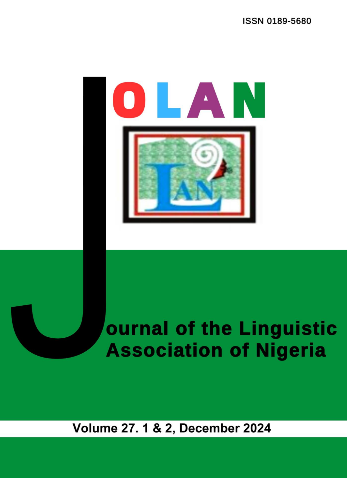Reversing the Endangerment Trend of Indigenous Nigerian Languages: Challenges and Prospects
Keywords:
endangerment, indigenous languages, advocacy campaignsAbstract
The study examines the challenges and prospects of reversing the endangerment state of indigenous Nigerian languages. It establishes the need to revive an endangered or dead language, but notes that there are challenges that should be considered before embarking on such an enterprise in order to achieve a good result. Some of the identified challenges are: the negative attitude of the people and government towards the languages, lack of self-enhancing opportunities in the use of the languages, the influence of English and the faulty Nigerian political structure. Also, the study considers the prospects of revitalizing the languages by highlighting the experiences and successes recorded by the Hebrew, Welsh and Maori language groups. Finally the study recommends ways of overcoming the identified challenges. These include restructuring Nigerian political system, making the languages more functional by creating self-enhancing opportunities in the use of the languages and engaging interest groups in language advocacy campaigns.
References
Ager, Simon (2009) “A Study of Language Death and Revival with a Particular Focus on Alanx Gaelic.” M. A. Dissertation, 2009. www.acaemia.edu. Accessed 20 Nov., 2016.
Awonusi, V.O. “Cycles of Linguistics History: The Development of English in Nigeria”. In A.B.K Dadzie and S.
Awonusi, (eds). Nigerian English: Influences and Characteristics. 46-66.
Balogun, T. A. (2013) “A Endangered Nigerian Language: The Case of Yoruba Language.”African Nebula, (6) 70-82
Bamgbose, A (1993) “Deprived, Endangered and Dieing Language.” Diogenes 16/4.1 1993.
Blench, R. (2011) “An Atlas of Nigerian Languages.” www.Rogerblench.info/languages/Africa. Accessed 20 Nov., 2016.
Crystal, D. (2000) Language Death. Cambridge: CUP. Federal Republic of Nigeria (2010) Nigeria Policy on Education. (1999) constitution of Federal Republic of Nigeria.
Fleres, A. (1989) Te Kohanga: A Maori Language Renewal Progran. Canadian
Journal of Native American Education, 16 (2) 78-88
Mowarin, M. (2004).“Language Endangerment in Urhoboland.” A Paper Delivered at the Fifth Annual Conference and Meeting of Urhobo Historical Society, Effurun, Nigeria, 29 -- 31, October ,2004.
Norris, M. I. (1998) “Canada’s Aboriginal Languages. Canadian Social Trend (Winter) (51) 8-15. www.search.ebscohost.com. Accessed 20 Nov., 2016
Ohiri-Aniche, C. (2014) “Local Languages for Global Citizenship: Spotlight on Science.”
Newsreport. Vanguard 26, February, 2014, ,Reyhner,J. (1995)Maintaining and Renewing Native Languages Bilingual Research Journal 19( 2) 279-304.
Whalen, D and D .K. Harrison (2009) “The World’s Endangered languages.” Microsoft@ Encarta{DVD} Redmond W.A: Microsoft Corporation, 2008.
Salawu, A.S. (2013) “Global English as the Enricher of the Worlds’ Language Landscape and Motivator of World Languicide: Nigeria as a Case Study”.
Linguistics and Glocalisation of African Languages for sustainable
Development: A Festshcrift in Honour of Prof. Kola Owolabi. Ibadan: Universal Akada Books Ltd.
Shohamy, E. (2008). At What Cost? Mthod of Language Revival and Protection.” In K. A. King, N. Schulling-Estes, L. Fogle, J. Lou and B. Soukup. (eds) Sustaining Linguistic Diversity Washington D.c. Goergetown University Press. 205-218.
Wurm, S.A. (1998). “Methods of Language Maintenance and Revival, with Selected Cases of Language Endangerment in the World. In Matsumura (ed), 191-211.














